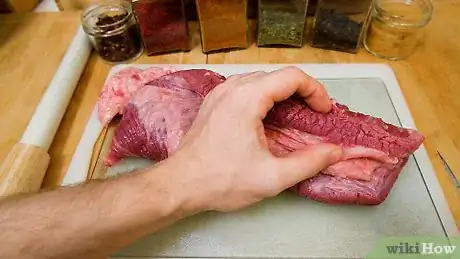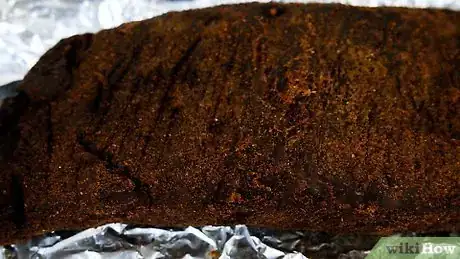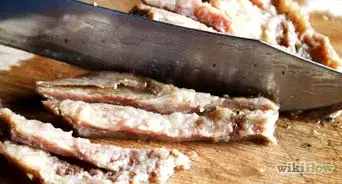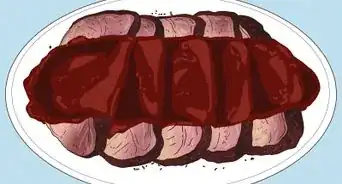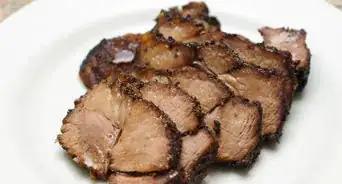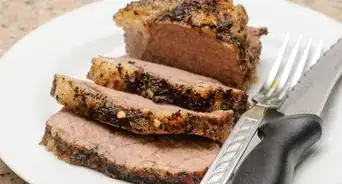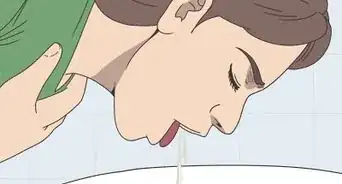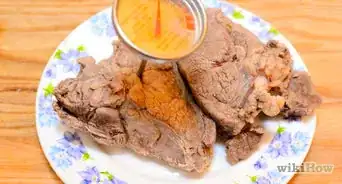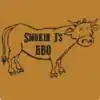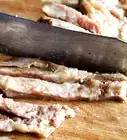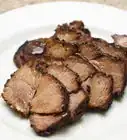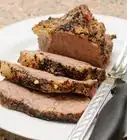This article was co-authored by Joshua & Jeremy George. Joshua and Jeremy George are BBQ Specialists and the Co-Owners of Smokin J’s BBQ in San Diego, California. With over six years of experience, they specialize in slow-smoked meats and making in-house rubs and sauces. Smokin J’s BBQ has been featured in many publications, including The BBQ Magazine.
There are 15 references cited in this article, which can be found at the bottom of the page.
This article has been viewed 483,657 times.
You want to smoke or braise a lovely brisket, but you're not sure how to cut such a large chunk of meat. Don't worry, the main rule you have to keep in mind is to cut against the grain once you've cooked it to create tender bites. Start by buying the cut of meat that's better for your dish and trimming off the excess fat. Then find the grain, and make thin slices against it.
Steps
Buying and Trimming a Raw Brisket
-
1Learn the different parts of a brisket. A brisket is made up of two muscles, the point and the flat. The muscles are separated by a thick, white seam of fat. The fat cap is a fat layer that sits on top of the brisket.
- The point is also called the deckle. This part of the brisket has the most fat on it. It has a marbled look, meaning there are more fat lines running through it.
- The flat cut is the part of the brisket that has less fat. As you may have guessed, it is also generally flatter than the point.
-
2Examine the brisket for redness and moistness. You want the brisket to look a little damp, so it will be juicy when cooking. However, you don't want it to look wet. Also, check for a nice red color.[1]
- When buying brisket, aim for 3 to 4 ounces (85 to 113 g) of meat per person.
- Look for the point cut for a fattier, more flavorful cut that's best for shredding. Look for the flat cut for a leaner meat that's better for slicing. A whole brisket includes both cuts.[2]
Advertisement -
3Cut the fat cap off in sections with a sharp slicing knife. The fat cap is the large layer of fat that's primarily on the point side of the meat. Some people trim it completely off, while others leave 1⁄8 to 1 inch (0.32 to 2.54 cm) of fat on the meat. Trimming it allows more seasoning to get to your meat, but the fat can provide some flavor.[3]
- To trim it completely off, work in sections across the meat. Slip your knife under the fat, and slide it back and forth until the section comes off.[4]
- To trim off part of the fat, just cut the top part of the fat off in the thicker sections. You may want to leave some fat on if you're smoking your brisket.
-
4Trim off the small pieces of fat on the underside of a flat cut. The flat cut will have a large amount of fat on one side and smaller pieces of fat on the underside. You will also see this in a whole brisket. You need to trim off the small pieces of fat, as they can act as a barrier between the meat and flavor.[5]
- Press the point of your knife under the edge of the fat. Push the knife under it, and then slice it off by see-sawing back and forth and sliding the knife outward.[6]
-
5Cut down the fat vein between the point and flat cut on a whole brisket. If you have a whole brisket, you'll have a large layer of fat between the 2 pieces. While you don't need to separate them completely, you do want to trim off some of this fat.[7]
- Start on the outer edge of the fat vein and shave off the fat in small chunks. Take off most of the fat, down to where you can see the meat below. You'll be able to lift up a chunk of the meat to put seasoning in the middle.[8]
Finding the Grain of the Cooked Brisket
-
1Examine the meat to find the grain on a flat or point cut. Place the brisket on a cutting board to study the brisket. The grain is how the strands of muscle run through the meat. It's like a long series of rubber bands, and you'll see the lines in the meat.[9]
-
2Check for the grain in 2 directions with a whole brisket. When the brisket is whole, the grain will run in different directions on the flat and point cut. Some people separate them as soon as they're done cooking to deal with this problem.[10]
- Alternatively, you can cut against the grain along the flat cut until you reach the point cut. Then, separate the 2 pieces from each other by lifting and slicing between them.
- A third option is to start cutting against the grain along the flat cut up to the point. Then, turn the meat 90 degrees, so that you're slicing at a 45-degree angle against the grain along both cuts of meat.
-
3Turn the meat so your knife is perpendicular to the grain. Cutting against the grain helps produce tender bites of meat. Therefore, once you find the grain, set your knife up so that you're slicing against the grain.[11]
- Going back to the rubber band analogy, think about chewing on a large rubber band. It would be tough and chewy, right? However, if you turn and cut the rubber bands so you get small pieces, it will break apart more easily in your mouth.
Slicing the Cooked Brisket
-
1Rest the cooked brisket for 20 minutes to 24 hours before slicing it. You should always let your meat rest at least 20 minutes after cooking to keep the juices in the meat. However, if you want very thin slices, wait until the next day when the brisket is cold to cut it.[12]
-
2Use a long serrated knife for slicing the brisket. While you can use any sharp knife, a serrated knife (the kind with points along the edge) will work best. The small points help you slice through the brisket.[13]
- Aim for a knife that is 8 to 10 inches (20 to 25 cm) long, which will allow you to slice more of the brisket at once.
-
3Use short strokes to go across your brisket against the grain. Don't try to cut all the way across a slice with one stroke. It won't work. Instead, see-saw your knife across the brisket, working your way from the top to the bottom. If your meat is especially wide, start at one end and work your way across an angle to cut off a slice.[14]
- You can also trim off extra fat as you go if you'd like.
-
4Aim for slices that are about a pencil-width thick. You can go thinner if the brisket seems tough, but this measurement is a good standard to work with. If it's falling apart, try a slightly thicker cut.[15]
Community Q&A
-
QuestionHow do I carve cooked brisket?
 Community AnswerThinly, like half the width of your pinkie fingernail, and perpendicular to the grain, or it'll be tough.
Community AnswerThinly, like half the width of your pinkie fingernail, and perpendicular to the grain, or it'll be tough. -
QuestionWhat liquids should I put in with a brisket?
 Community AnswerAll kinds of stuff. Worcestershire sauce. Guinness beer. A bottle of Bordeaux wine (think in the $10 range). No water, though -- the brisket will make all the liquid it needs.
Community AnswerAll kinds of stuff. Worcestershire sauce. Guinness beer. A bottle of Bordeaux wine (think in the $10 range). No water, though -- the brisket will make all the liquid it needs. -
QuestionWhat part of the brisket is used for burnt ends?
 Community AnswerIf you want to make burnt ends, use the pointed end of the brisket (also known as the deckle). This particular part of the brisket comes from the cow's pectoral muscle.
Community AnswerIf you want to make burnt ends, use the pointed end of the brisket (also known as the deckle). This particular part of the brisket comes from the cow's pectoral muscle.
Things You'll Need
- Brisket
- Sharp slicing knife
- Cutting board
- Long serrated knife or chef's knife
References
- ↑ https://www.bhg.com/recipes/how-to/cooking-basics/how-to-cook-brisket/
- ↑ https://www.thekitchn.com/corned-smoked-or-braised-brisket-can-do-it-all-meat-basics-217112
- ↑ https://www.youtube.com/watch?v=jrPl48YKdSQ&feature=youtu.be&t=63
- ↑ https://www.youtube.com/watch?v=qgUoI-DofjA&feature=youtu.be&t=83
- ↑ https://www.youtube.com/watch?v=QQ6UlUgo7OI&feature=youtu.be&t=54
- ↑ https://www.youtube.com/watch?v=tOmYm8g4D_U&feature=youtu.be&t=7
- ↑ https://www.youtube.com/watch?v=WUxMXCMMak4&feature=youtu.be&t=35
- ↑ https://www.youtube.com/watch?v=jrPl48YKdSQ&feature=youtu.be&t=8
- ↑ https://www.youtube.com/watch?v=Nqv0JquKqsE&feature=youtu.be&t=25
- ↑ https://www.texasmonthly.com/food/how-to-slice-a-brisket/
- ↑ https://www.youtube.com/watch?v=lkmA_dnAUA0&feature=youtu.be&t=59
- ↑ https://www.youtube.com/watch?v=lkmA_dnAUA0&feature=youtu.be&t=11
- ↑ https://www.texasmonthly.com/food/how-to-slice-a-brisket/
- ↑ https://www.youtube.com/watch?v=lkmA_dnAUA0&feature=youtu.be&t=82
- ↑ https://www.texasmonthly.com/food/how-to-slice-a-brisket/
About This Article
To cut a brisket, start by putting it on a cutting board with the fatty side facing up. Then, cut off the section of the brisket that has the least amount of fat on it. Cut against the grain of the meat, which is the direction the fibers go in, so the meat is more tender when you cook it. Once you separate the non-fatty section from the rest of the brisket, finish by cutting it in half so you have 2 small pieces and a large fatty piece. For more tips, including how to find the rain, read on!

